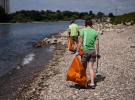One-quarter of World’s Crops Threatened by Water Risks
One out of every 11 people in the world grapples with hunger. A hidden and growing driver is lack of water.
New WRI analysis shows that one-quarter of the world’s crops are grown in areas where the water supply is highly stressed, highly unreliable or both. Mounting risks like climate change and increased competition for water are threatening water supplies and, in turn, food security. Rice, wheat and corn — which provide more than half the world’s food calories — are particularly vulnerable: 33% of these three staple crops are produced using water supplies that are highly stressed or highly variable.
These growing water challenges come as food demands are increasing: Research shows the world will need to produce 56% more food calories in 2050 than it did in 2010 to feed a projected 10 billion people.
Here, we analyze what escalating water risks mean for food production, using new data from WRI’s Aqueduct Food platform.
Farmers water their crops using rain that falls naturally or through irrigation, where water is diverted from rivers or reservoirs or pumped from underneath the ground to the land’s surface.
Both rainfed and irrigated crops are important for food security, but both face mounting threats.
Irrigated crops, which make up 34% of the world’s total production by weight, are vulnerable to increasing competition over shared water supplies, known as water stress. Water stress is considered “high” if at least 40% of the local water supply is used to meet demands from farms, industries, power plants and households.
bout 60% of the world’s irrigated crops (by weight) are currently grown in areas facing high or extremely high levels of water stress.
Rainfed crops, which make up the other 66% of the world’s total production, are vulnerable to erratic weather patterns.
Globally, 8% of the rainfed crops the world produces are grown in areas facing high to extremely high variations in annual water supply, places where rainfall patterns may swing wildly between drought and deluge.
The problem with growing crops in both highly stressed and highly variable areas is that there isn’t much of a supply buffer to weather shocks such as prolonged droughts. While farmers have adapted to a certain level of variability in the water they can use, increased water competition and climate change are stretching available supplies to the limit. Growing crops in these areas therefore puts food security in jeopardy.
Just a Handful of Countries Produce Most of the World’s Irrigated Crops — and They’re Rapidly Depleting Their Water
Just 10 countries — China, India, United States, Pakistan, Brazil, Egypt, Mexico, Vietnam, Indonesia and Thailand — produce 72% of the world’s irrigated crops, including sugarcane, rice, wheat, vegetables, cotton and maize. Two-thirds of these crops face high to extremely high levels of water stress. That’s a problem for food security as well as economies — irrigated crops are often “cash crops” exported to other nations.
Meanwhile, demand for irrigation is poised to grow. Agriculture is already the biggest driver of water stress, responsible for 70% of the world’s withdrawals. According to data on Aqueduct, the demand for water to irrigate crops is projected to rise by 16% by 2050, compared to 2019. Warming temperatures are partially driving this trend. The warmer it is, the thirstier crops become.
Some countries are already grappling with the tension between food production and water security. In India, nearly 270 million metric tons — or around 24% of the country’s total crop production — is grown in watersheds that use more water than what can be naturally replenished. The country has resorted to pumping non-renewable groundwater and rerouting its rivers, but these are not sustainable long-term solutions. Northern India already loses up to a foot of groundwater a year due, in part, to pumping for irrigation. Groundwater depletion may triple by 2080 as temperatures in India continue to warm.
Rainfed Agriculture Supplies Most of the World’s Crops, but Faces Increasingly Unstable Precipitation
The majority of the world’s food — 66% of all crop production — still comes from rainfed agriculture. For example, 75% of the world’s corn comes from rainfed farms, predominantly in the United States, China and Brazil.
Yet as climate change fuels longer, more frequent droughts and deforestation alters local precipitation patterns, farmers will find it increasingly difficult to grow rainfed crops. Already, 8% of rainfed agriculture (by weight) faces high to extremely high levels of variation in annual water supply. By 2050, 40% more rainfed crops will face unreliable water supplies than in 2020, with the greatest increases occurring in India, the U.S., Australia, Niger and China.
Niger, a country where almost 97% of the production relies on rainfed agriculture, suffers from one drought every three years on average. Almost half of children are chronically malnourished, and the situation is only posed to worsen: The ND-Gain Index named Niger as the most vulnerable country in the world for climate change-related impacts on food systems.
In addition to rainfall variability, political instability and conflict are prompting farmers in Niger to abandon their crops to avoid violence. At the same time, lack of employment is the biggest motivation for new recruits to join armed groups, creating a vicious cycle. This is just one example where food production, climate-driven water challenges, and conflict are colliding to exacerbate hunger and other issues.
It’s Still Possible to Produce More Food in a Water-constrained World
Stressed and variable water supplies don’t automatically spell crisis. With the right policies that address the nexus of food production, water management and conservation, businesses and governments can ensure that bread baskets remain full.
Some of the same strategies for sustainably managing water also address the climate and biodiversity crises, and improve people’s lives:
- Assess water risks and set meaningful targets: Corporations and governments alike must first understand the water risks they face, using granular data and mapping tools like Aqueduct and Aqueduct Food. Corporations should assess the water impacts of their own products and operations, as well as those of their suppliers. They should set meaningful targets to align with sustainability goals, such as science-based freshwater use targets.
- Reduce food loss and waste: One quarter of all water used for agriculture grows food that ultimately goes uneaten. Food is lost and wasted across all parts of the supply chain, from farm to table. Governments, businesses, farmers and consumers alike all must play a role in reducing it.
- Shift high-meat diets towards less water-intensive foods: One pound of beef requires 50 times more water to produce than one pound of potatoes. Choosing less water-intensive foods can substantially decrease water stress and unsustainable water use.
- Avoid dedicating land to bioenergy: Diverting farmland to biofuel production increases competition for both land and water resources, and can adversely affect water quality.
- Increase water use efficiency: Farmers should use more efficient water measures, such as switching to water-efficient crops or using methods like sprinkler or drip irrigation versus flooding fields.
- Invest in nature-based solutions: Conservation and nature-based solutions can boost water security. For example, protecting and restoring forests helps regulate rainfall in nearby areas. Regenerative practices like agroforestry can help water infiltrate the soil, reducing reliance on irrigation and replenishing groundwater.
- Support inclusive water management: Water managers should ensure that water is distributed equitably throughout a basin — not prioritizing corporate farms over small family farms. Water infrastructure like dams and irrigation systems must be built and maintained in ways that do no harm. And water managers must plan for sustainable water use and access for future as well as current generations.
Producing more food in ways that protect nature and alleviate water challenges is a delicate balance. The world needs to prioritize sustainable water use today to ensure adequate water— and food — for tomorrow.
Cover photo: Alf Ribeiro/Alamy




